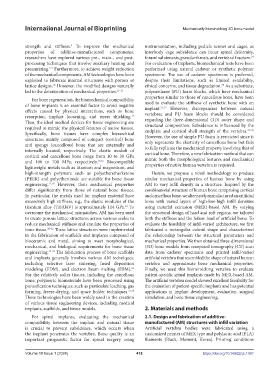Page 426 - IJB-10-1
P. 426
International Journal of Bioprinting Mechanically biomimicking 3D bone model
strength and stiffness. To improve the mechanical instrumentation, including pedicle screws and cages, as
4
properties of additive-manufactured components, interbody cage subsidence can incur spinal deformity,
researchers have explored various pre-, main-, and post- foraminal stenosis, pseudarthrosis, and vertebral fracture.
29
processing techniques that involve auxiliary heating and For evaluation of implants, biomechanical tests have been
pressurizing. Furthermore, to achieve weight reduction performed using natural cadaver or synthetic polymer
5-9
of the mechanical components, AM technologies have been specimens. The use of cadaver specimens is preferred,
exploited to fabricate internal structures with porous or despite their limitations, such as limited availability,
lattice designs. However, the modified designs naturally ethical concerns, and tissue degradation. As a substitute,
30
10
led to the deterioration of mechanical properties. 11-13 polyurethane (PU) foam blocks, which have mechanical
For bone regeneration, the biomechanical compatibility properties similar to those of cancellous bone, have been
of bone implants is an essential factor to avoid negative used to evaluate the stiffness of synthetic bone with an
31,32
effects caused by physical interactions, such as bone implant. However, discrepancies between natural
resorption, implant loosening, and stress shielding. vertebrae and PU foam blocks should be considered
14
Thus, the ideal medical devices for tissue engineering are regarding the three-dimensional (3D) outer shape and
required to mimic the physical features of native tissues. structural composition. Subsidence is influenced by the
33-35
Specifically, bone tissues have complex hierarchical endplate and cortical shell strength of the vertebra.
structures mainly composed of compact (cortical) bone However, the use of simple PU foam is restricted since it
and spongy (cancellous) bone that are externally and only represents the elasticity of cancellous bone but fails
internally located, respectively. The elastic moduli of to fully replicate the mechanical property involving that of
cortical and cancellous bone range from 10 to 30 GPa cortical bone. Therefore, a new fabrication method that can
and 100 to 700 MPa, respectively. 15,16 Biocompatible mimic both the morphological features and mechanical
lightweight metals such as titanium and magnesium, and properties of native human vertebra is required.
high-strength polymers such as polyetheretherketone Herein, we propose a novel methodology to produce
(PEEK) and polyetherimide are suitable for bone tissue similar mechanical properties of human bone by using
engineering. 17,18 However, their mechanical properties AM to vary infill density in a structure. Inspired by the
differ significantly from those of natural bone tissues. combinatorial structure of human bone comprising cortical
In particular, the metals used for implant material have and cancellous bone, we alternately manufactured an artificial
excessively high stiffness, e.g., the elastic modulus of the bone with varied layers of high-low-high infill densities
titanium alloy (Ti6Al4V) is approximately 114 GPa. To using material extrusion (MEX)-based AM. By varying
19
overcome the mechanical mismatches, AM has been used the structural design of hard and soft regions, we tailored
to create porous lattice structures across various scales to both the stiffness and the failure load of artificial bone. To
reduce mechanical stiffness and emulate the properties of evaluate the feasibility of infill-varied architecture, we first
bone tissue. 20-22 These lattice structures were implemented fabricated a rectangular cuboid shape and characterized
in the fabrication of scaffolds and implants composed of the relationship between the structural parameters and
bioceramic and metal, aiming to meet morphological, mechanical properties. We then obtained three-dimensional
mechanical, and biological requirements for bone tissue (3D) bone models from computed tomography (CT) scan
engineering. 23-25 The fabrication process of bone scaffolds data from cadaver specimens and printed infill-varied
and implants generally involves various AM techniques, artificial vertebra that resembled the shape of natural human
including selective laser sintering, fused deposition vertebra and approximate bone mechanical properties.
modeling (FDM), and electron beam melting (EBM). Finally, we used this biomimicking vertebra to evaluate
26
For the relatively softer tissues, including the cancellous patient-specific spinal implants made by MEX-based AM.
bone, polymeric biomaterials have been processed using The artificial vertebra model showed excellent feasibility for
porosification techniques, such as particulate leaching, gas the evaluation of patient-specific implants and has potential
forming, freeze-drying, and space holder techniques. 27,28 applications in implant development, evaluation, surgical
These technologies have been widely used in the creation simulation, and bone tissue engineering.
of various tissue engineering devices, including medical
implants, scaffolds, and tissue models. 2. Materials and methods
For spinal implants, evaluating the mechanical 2.1. Design and fabrication of additive-
compatibility between the implant and natural tissue manufactured (AM) structures with infill variation
is crucial to prevent subsidence, which occurs when Artificial vertebra bodies were fabricated using a
the implant penetrates the vertebra. Bone quality is an customized printer of MEX type and polylactic acid (PLA)
important prognostic factor for spinal surgery using filaments (Black, Moment, Korea). Printing conditions
Volume 10 Issue 1 (2024) 418 https://doi.org/10.36922/ijb.1067

